As modern people, there are two things we cannot live without: one is a smartphone, and the other is the internet. These two are very familiar to everyone and can be considered standard configurations.
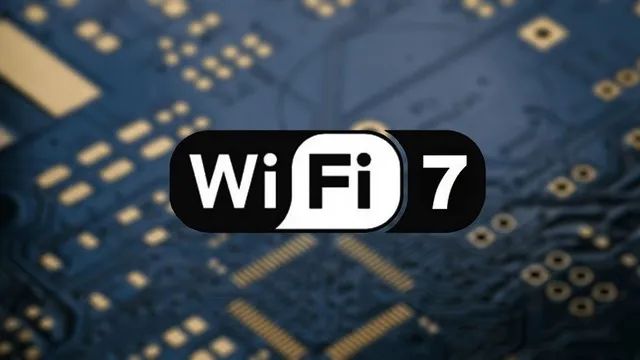 Smartphones improve every year, and network technology is certainly not idle. Not only is the 4G cellular network iterating towards 5G, but Wi-Fi is also entering the next stage of development. Just recently, the 7th generation Wi-Fi technology (also known as IEEE802.11be or Wi-Fi 7) has officially emerged, bringing improvements in speed, latency, and bandwidth.
Smartphones improve every year, and network technology is certainly not idle. Not only is the 4G cellular network iterating towards 5G, but Wi-Fi is also entering the next stage of development. Just recently, the 7th generation Wi-Fi technology (also known as IEEE802.11be or Wi-Fi 7) has officially emerged, bringing improvements in speed, latency, and bandwidth.
The arrival of new technology is certainly eye-catching, but for the general public, Wi-Fi 7 is still in a very early stage. This means that widespread use of Wi-Fi 7 may have to wait until after 2024, so everyone still has to stick with Wi-Fi 6.

Wi-Fi 6 Is Good, But Experience Still Has Limitations
Of course, the Wi-Fi 6 technology itself is certainly not lacking; it can even be said to be excellent. Compared to Wi-Fi 4 and Wi-Fi 5, Wi-Fi 6 has many more improvements:
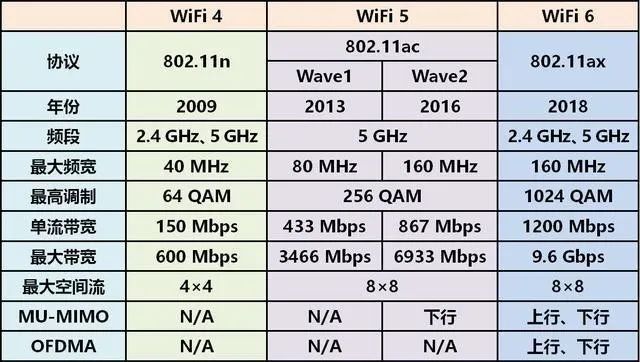 First, it has faster speeds and lower latency, with a theoretical maximum data throughput of 9.6Gbps and latency as low as 20ms;
First, it has faster speeds and lower latency, with a theoretical maximum data throughput of 9.6Gbps and latency as low as 20ms;
Then it supports OFDMA and MU-MIMO features. The former can be understood as subdividing a data transmission channel into smaller channels and allocating these channels to different connected devices, making it suitable for smart home scenarios where the bandwidth requirement is not particularly high.
The latter essentially adds more pathways, making it suitable for applications requiring larger bandwidth, such as watching 4K streaming movies on a tablet while playing competitive games on a smartphone, etc.
Additionally, Wi-Fi 6 has a significant advantage in power saving, which is the TWT feature. Under this function, when there is data to be transmitted or received, your device starts working; otherwise, the device will go to sleep, achieving the goal of reducing power consumption, saving energy, and improving battery life.
In summary, Wi-Fi 6 is quite impressive; not only does it have ultra-high speeds, but it can also leverage the significant advantages of home gigabit networks, while also featuring high concurrency, low latency, energy efficiency, and anti-interference capabilities. Therefore, if you just want to create a smooth and stable internet environment, Wi-Fi 6 can theoretically meet the networking needs of individuals, families, and office scenarios.
 However, it is important to note that this is only theoretical because the actual usage environment is much more complex than the ideal. On one hand, the application scenarios have changed dramatically. For instance, when watching videos and live streams, the content resolution used to generally be no more than 1080P, but now 1080P is just the starting point, with 4K and even 8K content being common. Users occasionally also want to play large games and AR/VR, which is entirely different in terms of application scenarios.
However, it is important to note that this is only theoretical because the actual usage environment is much more complex than the ideal. On one hand, the application scenarios have changed dramatically. For instance, when watching videos and live streams, the content resolution used to generally be no more than 1080P, but now 1080P is just the starting point, with 4K and even 8K content being common. Users occasionally also want to play large games and AR/VR, which is entirely different in terms of application scenarios.
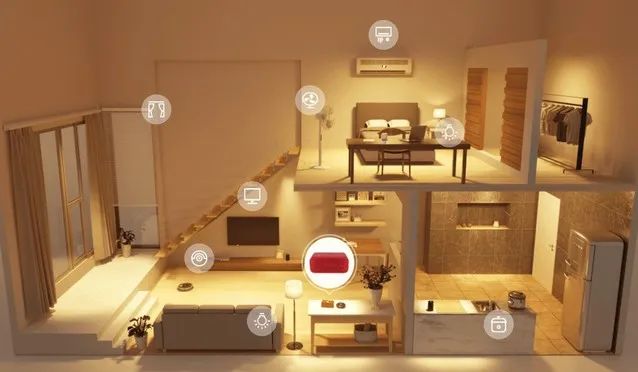 On the other hand, today, the devices that need to be connected at home are not just smartphones and tablets; even large appliances like refrigerators, air conditioners, and TVs, as well as smaller devices like door locks, lamps, speakers, and air purifiers all need to be connected. If one word could describe the home networking environment, it would be ‘crowded’, which speaks volumes about the quality requirements for the network.
On the other hand, today, the devices that need to be connected at home are not just smartphones and tablets; even large appliances like refrigerators, air conditioners, and TVs, as well as smaller devices like door locks, lamps, speakers, and air purifiers all need to be connected. If one word could describe the home networking environment, it would be ‘crowded’, which speaks volumes about the quality requirements for the network.
It is undeniable that the arrival of Wi-Fi 6 does meet basic network needs, but limitations still exist. It will also be restricted by user scenarios, such as network bandwidth, terminal devices, and even the area and structure of the house. For users, the impact on experience is still quite significant.
So, is there a good solution? The answer is ‘yes’.

How Does Wi-Fi Change the Wireless Connection Experience?
Wi-Fi has developed to this day, and the technical standards correspond to only the most basic experience. For manufacturers, not being satisfied with the standards is the norm. Therefore, on top of the basic Wi-Fi standards, some unique technical routes have also emerged, among which the 2×2 MIMO dual-path Wi-Fi technology directly improves user experience.
Before discussing 2×2 MIMO dual-path Wi-Fi, we should first understand MIMO, which stands for Multiple Input Multiple Output. We know that smartphones require antennas to receive and transmit signals, and MIMO consists of m transmitting antennas and n receiving antennas forming an antenna system.
Generally speaking, traditional smartphones are single-antenna systems, or 1×1 Wi-Fi, while smartphones equipped with ‘2×2 Wi-Fi’ technology typically have dual antennas, meaning they have two sets of antenna groups. During wireless data transmission and reception, the former has only one antenna responsible, while the latter has two antennas serving simultaneously, resulting in double the data throughput and naturally higher efficiency.
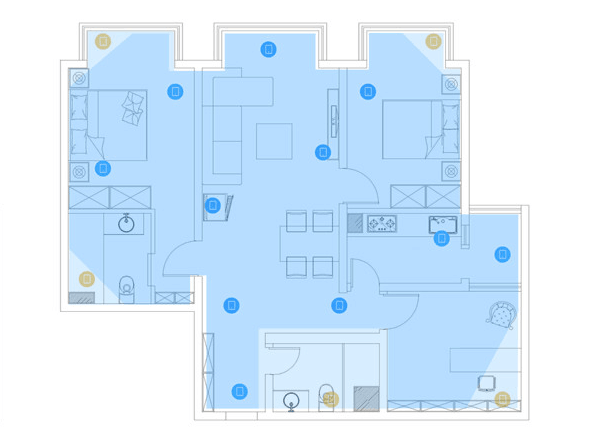 Additionally, smartphones with dual-path Wi-Fi have stronger signal searching capabilities and broader coverage than single-antenna devices, effectively addressing issues in larger homes with many blind spots. If you are a mobile gaming enthusiast, you also don’t have to worry about signal blockage when holding the phone horizontally, as smartphones with two antenna modules can avoid this problem as well.
Additionally, smartphones with dual-path Wi-Fi have stronger signal searching capabilities and broader coverage than single-antenna devices, effectively addressing issues in larger homes with many blind spots. If you are a mobile gaming enthusiast, you also don’t have to worry about signal blockage when holding the phone horizontally, as smartphones with two antenna modules can avoid this problem as well.
Because of this, when selecting smartphones and routers, it becomes very necessary to choose devices that support 2×2 Wi-Fi, which is a technology that significantly enhances connectivity.

How Powerful Is Qualcomm’s 2×2 Wi-Fi 6 Solution?
It is worth mentioning that as one of the industry leaders, Qualcomm was one of the first manufacturers to promote 2×2 Wi-Fi technology. As early as 2017, Xiaomi 6 and OnePlus 5 both used 2×2 Wi-Fi as an important selling point for external promotion. The reason these two flagship models support this capability is due to the Snapdragon 835 chip they are equipped with.
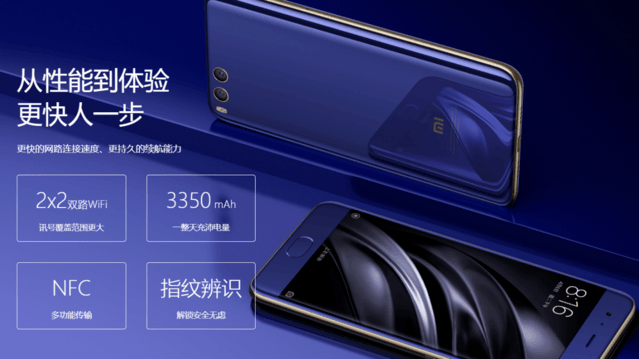 Xiaomi 6
Xiaomi 6
In fact, any smartphone equipped with the Snapdragon 835 chip had notable capabilities in ‘grabbing the network’, regardless of the environment. Especially in densely populated and complex environments, Snapdragon 835 smartphones had fast download speeds without stuttering, and low-latency gaming experiences. Later, Qualcomm also brought this technology down to mid-range and low-end chips, such as the Snapdragon 660 and Snapdragon 710, allowing more mobile devices to enjoy flagship-level wireless connectivity experiences, and many users clearly felt the experience upgrade brought by this technology.
With the widespread application and popularization of Wi-Fi 6 technology, dual-path Wi-Fi has evolved from the 2×2 Wi-Fi 5 on the Snapdragon 835 to today’s 2×2 Wi-Fi 6, marking a new stage in wireless connectivity development.
As mentioned earlier, Wi-Fi 6 already possesses outstanding connectivity capabilities, but with the support of Qualcomm’s 2×2 Wi-Fi 6, this enhancement becomes even more significant.
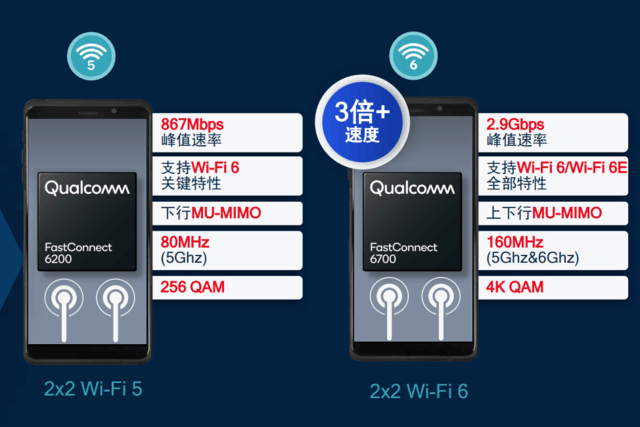 Taking Qualcomm’s FastConnect 6700 mobile connectivity system as an example, it supports 2×2 dual-path Wi-Fi 6/Wi-Fi 6E, not only bringing peak rates of up to 2.9Gbps but also supporting uplink and downlink MU-MIMO, 4KQAM, and differentiated advantage technologies like 160MHz channels in the 5GHz and 6GHz bands. In other words, users using smartphones equipped with Snapdragon 8 series mobile platform chips can easily obtain the best mobile wireless networking experience in applications such as mobile gaming, ultra-high-definition streaming, and high-performance computing—faster speeds, lower latency, and greater stability for multiple device connections, which is quite nice.
Taking Qualcomm’s FastConnect 6700 mobile connectivity system as an example, it supports 2×2 dual-path Wi-Fi 6/Wi-Fi 6E, not only bringing peak rates of up to 2.9Gbps but also supporting uplink and downlink MU-MIMO, 4KQAM, and differentiated advantage technologies like 160MHz channels in the 5GHz and 6GHz bands. In other words, users using smartphones equipped with Snapdragon 8 series mobile platform chips can easily obtain the best mobile wireless networking experience in applications such as mobile gaming, ultra-high-definition streaming, and high-performance computing—faster speeds, lower latency, and greater stability for multiple device connections, which is quite nice.
Final Thoughts:
By now, I believe everyone can understand the extraordinary aspects of 2×2 Wi-Fi 6. In simple terms, Wi-Fi 6 is strong, but 2×2 Wi-Fi 6 is even stronger, truly providing users with a ‘no-compromise’ wireless experience.
Of course, a better wireless connection experience also relies on hardware technology updates. Whether it’s the Qualcomm Snapdragon series mobile platforms or the Qualcomm professional networking platform Networking Pro series, they all provide crucial support for enhancing Wi-Fi experiences. Today, Qualcomm’s Wi-Fi 7 related technologies have also been officially released, and I believe they will soon bring even more extreme networking experiences, which is definitely worth everyone’s attention and anticipation.
